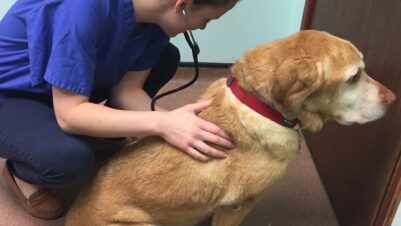IN recent decades, the change in attitudes towards pet loss seems extraordinary. Quite rightly, it is now commonplace to spend time preparing clients and handling euthanasias as sensitively as possible.
We offer choice when disposing of a valued companion animal’s remains and readily proffer details of support groups should grieving owners get stuck somewhere on the road to acceptance and recovery.
Progress enough perhaps, but better still we now discuss whether pets should be present at the euthanasia of a companion. Is it best they stay throughout or just view the body afterwards? What is the ideal plan with cats, dogs and small furries when the animal to which they are bonded dies naturally?
Despite some continued scepticism, such conversations no longer seem bizarre to those of us who spend our professional lives in small animal practice. And a good thing too. We owe it to clients who place their trust in our professionalism and rightly expect compassion from all those our side of the consulting table.
We also owe it to ourselves, because such situations can be excruciating in the emotional demands they place upon us. By bringing these issues into the open and discussing how we respond to them, the results of our actions and how such demanding and potentially stressful situations make us feel, we learn.
We pass on valuable techniques, our skills improve and knowledge of this important area moves forward.
Reactions vary
Sadly, however, no matter what advances we have made in understanding the emotional consequences of euthanasia, the need for pet loss counselling and supporting colleagues during and after the more harrowing incidents that crop up from time to time, we still have a long way to go.
Nowhere is this more evident than when it comes to preparing companion pets for the often significant emotional fall-out that can result from the loss, natural or clinically induced, of another pet from the same household. In many cases things soon settle down and no one suffers for long. Indeed, in some homes the anticipated upset is never seen. The pets and people left behind simply continue as if nothing untoward has happened.
In other circumstances, though, the reaction of the remaining pet is so profound that its owners’ grief is intensified and prolonged simply because of the deep distress displayed by the animal they still have. There are, of course, some scenarios where a high risk in this respect is fairly obvious. After the demise of an elderly sibling, or when offspring kept from a home-bred litter lose a parent quite late in life, people usually expect and prepare for a significant period of adjustment.
Some pets suffer badly
As these situations so closely mirror human experience, it is unsurprising that we are more aware of the potential for problems than when we have brought unrelated animals together in a multi-pet home. Yet it is from such households that an increasing number of referrals for post-pet loss problem behaviour come.
Cats are sometimes unsettled by the permanent disappearance of a favoured companion of the same or a different species, but even when bonded, the more independent feline lifestyle means that significant periods of time are often spent apart. Whereas dogs that bond closely generally spend the majority of their lives together.
They are inevitably sent into the garden to relieve themselves together, fed, walked and tucked up at night in close contact, put into boarding kennels at the same time, and, as we advise owners to let their dogs have “happy” veterinary visits, they even accompany their companions to the clinic. Thus, some dogs are quite literally never apart until that fateful day when death intervenes.
As if that wasn’t bad enough, the profound upheaval in their lives is generally worsened by their bereaved owners’ distress. At the best of times outbursts of remorse and tearful episodes frequently upset dogs. When their worlds have just turned upside down, the mood swings, irritability, quietly contained sadness or overt outpourings that constitute human grief are at best unlikely to help them cope.
At worst, in their need for solace, many people become unintentionally emotionally over-demanding and intrusive, clinging to the remaining pet in such a way that it in turn becomes more dependent, and even less able to adjust and cope alone for the first time ever. Unfortunately, the quality of advice given at such times, if advice of any sort is forthcoming, seems highly variable and frequently based on personal experience alone. Whilst the intention may be good, as we all vary in the relationships we form with our companion animals and the demands we place upon them, this can often complicate an already fraught situation.
Sensitive handling helps
What, therefore, should we say? Given that circumstances vary and “should” does not apply when it comes to death and grief, a good rule of thumb is to do whatever seems appropriate to the individual with regard to staying during euthanasia and seeing the departed pet’s body.
So long, of course, as owners can contain their distress sufficiently well for it not to have a knock-on negative effect upon the remaining pet. Another proviso, perhaps, must be that the clinician judges a completely uninterested response will not subsequently lead to retribution because the pet left behind is viewed as uncaring, something that is occasionally seen.
Once home, crying in private and not in front of the pet, keeping routines entirely normal and leaving as many things as possible with the departed pet’s scent around are essential. As odour matters so much in the animal kingdom, the latter is crucially important, a common response being to quickly remove every sad reminder from human view.
Commercial pheromone preparations may also help and emphasis must be placed on reassurance being best delivered in the form of a jolly game or interesting outing rather than attention which rewards and reinforces a pet’s distress or, worse still, food!






